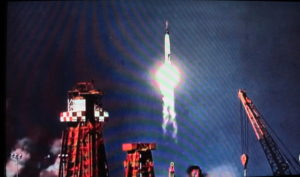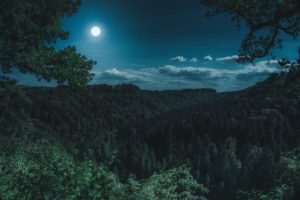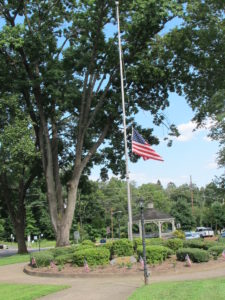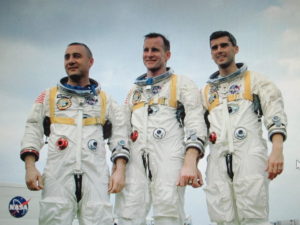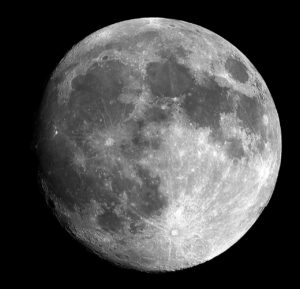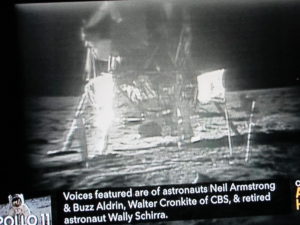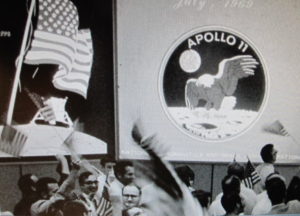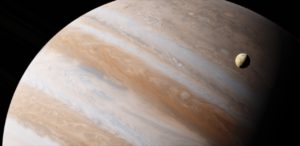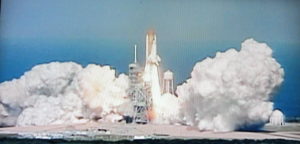2019
Fifty years ago today, NASA successfully landed the first manned expedition to the moon.
The United States wasn’t the first, though, to send a manned spaceship into Earth’s orbit. That distinction belongs to the Soviet Union. Yuri Gagarin aboard Vostok 1 was the first to orbit the Earth, once, on April 12, 1961. The image of the American astronauts planting the flag on the moon is indelibly fixed in our minds. But many earlier milestones laid the “groundwork” in the evolution of this remarkable achievement.
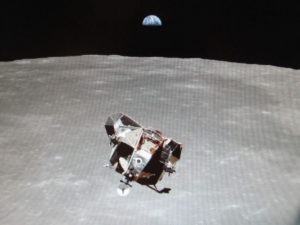
Photographed from Command Module by Pilot Michael Collins, showing Lunar Module ascending toward Command Module. Earth in distance.
The Space Age Begins
On October 4, 1957, the Soviet Union launched the world’s first artificial satellite. Sputnik I, at only 23″ in diameter and weighing 184 pounds, took 98 minutes to orbit the Earth on its elliptical path. Soon after that first flight, Sputnik II carried a dog named Laika into space on November 3, 1957.
At the time, relations between the United States and the Soviet Union were less than cordial. The Soviet Union’s launch into space suggested the possibility of nuclear weapons transport on spacecraft. This, then, prompted the United States Defense Department to fund, with Congress’ approval, the National Aeronautics and Space Administration. The “Space Act” formally created NASA in July of 1958, partly to maintain our technological edge over other countries.
The Space Age had begun.
Moon Voyages: The Soviet Union and The United States
President Dwight D. Eisenhower, in February, 1959, asked NASA to compile a list of military test pilots who met certain requirements. These 110 aviators were candidates under consideration for Project Mercury, the first crewed space program.
The Luna Missions
On September 13, 1959, the Soviet Union sent Luna 2, an uncrewed spacecraft, to the first impact landing on the moon’s surface. This is the first time a man-made object made contact with the moon. And on October 4, Luna 3 took the first photographs from the far side of the moon in a “fly-by”. Luna 1, earlier in 1959, failed to land. Both nations can count many losses of equipment in those early years of space exploration, but, certainly, valuable information was gained.
Alan Shepherd
Astronaut Alan Shephard was the first American to reach suborbital flight on May 5, 1961. This was less than a month after Gagarin’s historic accomplishment. Shephard flew on Freedom 7, with a Mercury-Redstone rocket.
John Glenn
Less than a year later, on February 20, 1962, John Glenn became the first American to orbit Earth. He completed three orbits on board Friendship 7. The space race was underway, sparked by something said by President John F. Kennedy in a 1961 speech. He challenged us to land a man on the moon and to safely return him to Earth before the end of the decade. President Kennedy prohibited Glenn from making another space flight, in order to protect this American hero.
A few years earlier, on July 16, 1957, Glenn completed the first supersonic flight across the United States. Called Project Bullet, Glenn averaged 586 miles per hour, including three refuelings. The trip lasted 3 hours, 23 minutes, and 8.3 seconds, and the country was continuously photographed in panoramic mode.
Wally Schirra
Walter (Wally) Schirra was one of those original 110 test pilots chosen by NASA. Schirra was born on March 12, 1923, in Hackensack, New Jersey, and was raised in Oradell, where I grew up. On October 3, 1962, his first flight was designed to examine support systems of the spacecraft, Sigma 7. Another task was to test space suits. At one point, Schirra’s suit heated to 90º F, but he was able to fix the problem. On this mission, Sigma 7 orbited the Earth 6 times during a 9 hour flight.
More Firsts
The first woman in space was Valentina Tereshkova, from the Soviet Union. She flew on Vostok 6, on June 16, 1963. By the end of 1963, the United States had launched two astronauts into suborbital flights and four into orbit.
On December 4, 1965, Wally Schirra and Tom Stafford began a two-week mission aboard Gemini 7. During the flight, Schirra injected a little levity by reporting a UFO sighting to Houston Mission Control. He implied that he had seen Santa Claus. The joke came with sound effects, as Schirra played “Jingle Bells” on the harmonica he had smuggled aboard. Stafford also had a part to play–ringing the sleigh bells!
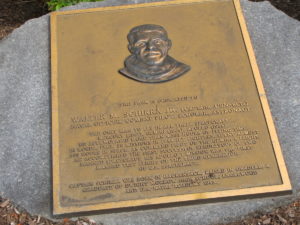 Schirra was the only astronaut to have flown in 3 NASA programs–Mercury, Gemini, and Apollo. The borough of Oradell, New Jersey, celebrated his accomplishments with a joyous red-white-and-blue parade down Kinderkamack Road to Oradell Avenue. Yes, I was there.
Schirra was the only astronaut to have flown in 3 NASA programs–Mercury, Gemini, and Apollo. The borough of Oradell, New Jersey, celebrated his accomplishments with a joyous red-white-and-blue parade down Kinderkamack Road to Oradell Avenue. Yes, I was there.
A park at that intersection must have a plaque commemorating his achievements; I’ll check next time I visit. (***Update***: Yes, there’s a plaque. Below is the town park, at the intersection of Oradell Ave. and Kinderkamack Rd.; the plaque sits at the base of the flag. August 13, 2019.)
Harry Carlisle, my father and a professional photographer, compiled an exhaustive pictorial account of Wally Schirra’s work in the space program. He donated it to the Oradell Public Library…from where it promptly was stolen.
Successes and Tragic Failures
After a few failures in the unmanned U.S. Pioneer program, the Ranger mission first impacted the moon on January 30, 1964. A series of successful crash impacts and soft landings (1964-1965) yielded many thousands of photographs.
The Soviet Union’s Alexei Leonov performed the first space walk on March 8, 1965. In 1966, the U.S.S.R. made the first soft landing on the moon. Their Luna 9 and Luna 13 missions sent the first pictures from the lunar surface.
The U.S. Surveyor 5 mission took tens of thousands of photographs. It also made the first use of an Alpha scatter soil composition monitor, on September 8, 1967. This device analyzed soil composition to help determine safe landing spots on the lunar surface.
Apollo 1
After the successful Mercury and Gemini missions, the Apollo program was designed to go a step further. Goal: take humans to the moon! At the Kennedy Space Center launch pad in Florida on January 27, 1967, Virgil (Gus) Grissom, Ed White, and Roger Chaffee, aboard Apollo 1, were scheduled to run systems tests prior to a future launch. Disaster struck when an electrical arc ignited the pure oxygen atmosphere inside the Command Module, killing all three astronauts.
Grissom was the second American in space, on the Liberty Bell 7, during the second Mercury flight in 1961. White spent 36 minutes as the first American to space walk, outside Gemini 4 in 1965. And this was going to be Chaffee’s first space flight.
The Space Shuttles
Two additional disasters that claimed lives occurred in the space shuttle program. In 1986, Challenger exploded a mere 73 seconds after liftoff, killing all 7 crew members. This is one of those events that made such an impact that most of us can recall exactly where we were when we first heard about the catastrophe. I had just left an office building in Rockville, Maryland, where I maintained interior plants for Springtime Environments.
The second incident, in 2003, involved the Columbia Space Shuttle. It disintegrated during its return into the atmosphere, killing the crew of 7.
As in all human endeavors that reach ever farther into the realm of discovery, risk is part of the equation. Every achievement attests to the precision of scientific research and application. These milestones inspire awe and we applaud the contributions made by these courageous men and women.
Testing His Wings
In the first flight after the Apollo 1 tragedy, Wally Schirra, Donn Eisele, and R. Walter Cunningham flew in the Apollo 7 mission on October 11, 1968. This first three-person crew to venture into space tested the Command and Service Modules (CSM) in Earth’s orbit. This flight included the first live television broadcast from an American spacecraft. Success of this mission paved the way for the proximate Apollo 8 mission and the moon landing in 1969. For each of these astronauts, this was the last space flight they would make.
From December 21 to December 27, 1968, Frank Borman, Jim Lovell, and William Anders were the first to travel beyond low Earth orbit and to fly into deep space. (Goose bumps!) Apollo 8 orbited 10 times around the moon, and safely returned back home.
Armstrong, “The Eagle Has Landed”: 7/20/1969
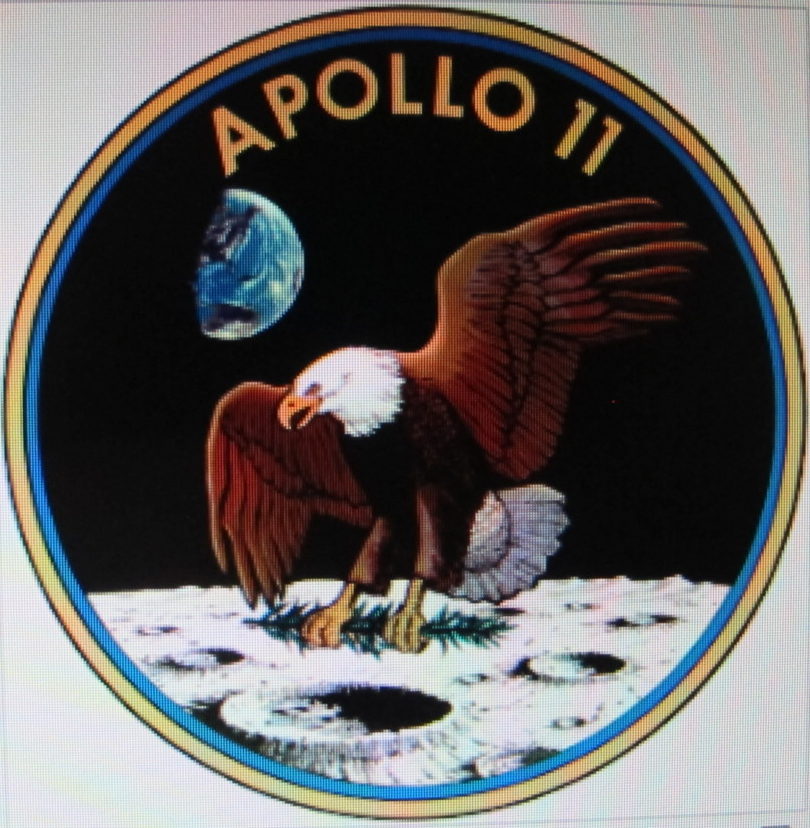
The Apollo 11 insignia, designed by Michael Collins. Names not included to signify effort made by all participants.
Preparation
The goal envisioned by President Kennedy in 1961 was about to be realized. Government scientists, university scholars, and engineers and scientists from the private sector made incredible progress.
Altogether, 400,000 people contributed to the Apollo 11 moon mission. They included contractors who made the space suits, medical experts, and mathematicians and astrophysicists who worked on the spacecraft and the launch. All communications and camera equipment, containers for rock samples, fabrics and fasteners—everything had to follow strict manufacturing specifications. No detail was too small for consideration.
Apollo 11
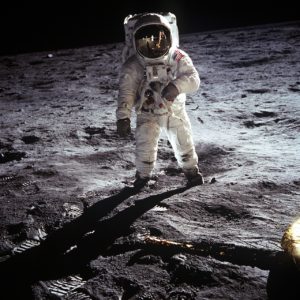
Buzz Aldrin.
Neil Armstrong, Edwin (Buzz) Aldrin, and Michael Collins boarded on July 16, 1969. After launching atop the powerful Saturn V rocket, the spacecraft reached speeds of up to 17,000 miles per hour. (“Buzz” is from Aldrin’s young sister’s mispronunciation of the word brother, or “buzzer”. He took it as his legal name in 1988.)
The astronauts orbited one and a half times around Earth before they reached the moon, 238,800 miles away. The trip took 3 days, 3 hours, and 49 minutes. But before setting the Lunar Lander onto the moon, the Command Module, Columbia, orbited 30 times.
Eagle safely descended into the Sea of Tranquility, about 1200′ west of the West crater. Command Module pilot Collins remained on board the Columbia, orbiting the moon. All this work and anticipation culminated in the historic July 20, 1969, landing. These brave Americans were the first to land and walk on the surface of the moon.
The Apollo 11 mission delivered, 50 years ago today!
Moon Walk
But Neil Armstrong didn’t step off the Lunar Lander until 6 hours after landing. Armstrong, as Commander of the Lunar Lander, was chosen to be the first to step foot on the moon at 10:56 p.m., followed 19 minutes later by Aldrin. Upon making contact with the lunar surface, he uttered the unforgettable, “This is one small step for a man, one giant leap for mankind.”
The astronauts installed instruments (sensing seismic activity, solar wind) on the moon that would relay data back to Earth. Armstrong spent 2 hours, 31 minutes, and 40 seconds on the surface of the moon. Aldrin and Armstrong gathered 47.5 pounds of rocks and “soil” from below the surface. And they placed the American flag a short distance from the Eagle.
CBS News broadcast the entire trip, with Walter Cronkite and Wally Schirra narrating the events. At one point, they pondered whether the flag would remain standing when the Eagle departed to meet Columbia. I have heard that it did not. But another flag was planted on the moon’s surface during a subsequent mission.
Time To Go
Aldrin and Armstrong remained at the landing site for 22 hours and 37 minutes. When it was time to leave, the Lunar Lander docked with the Command Module, flying overhead. After a successful and momentous expedition, the three astronauts headed home in the Command Module.
The Command Module was the only section to make the trip home. It safely splashed down in the Pacific Ocean on July 24, 1969, a few miles from the recovery ship, the U.S.S. Hornet. The Apollo 11 mission logged over 1,000,000 miles during this incredible eight-day exploration.
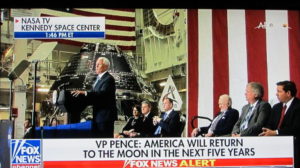
Vice President Mike Pence honoring the 50th anniversary of the work and success of the Apollo 11 mission, 7/20/2019. Buzz Aldrin, third from right.
More Accomplishments
In 1970 and 1973, the U.S. sent 5 unmanned rover missions to the moon. More “firsts” include Vladimir Remek, from Czechoslovakia, on March 2, 1978, the first in space from a country other than the U.S. or the U.S.S.R.
Sally Ride was the first American woman in space, and the youngest person in space, on June 18, 1983. Ride’s mission on Space Shuttle Challenger was to deploy two communications satellites. On July 25, 1984, Svetlana Savitskaya, from the Soviet Union, became the first woman to walk in space. And Yang Liwei was the first person from China to venture into Earth’s orbit on November 15, 2003.
More Apollo Missions
From the beginning of space flight through 1972, 6 Apollo missions landed 12 men on the moon. Briefly:
Apollo 9–James McDivitt, David Scott, Russell Schweikart.
Apollo 10–Thomas Stafford, John Young, Eugene Cernan. Didn’t land, first live color TV transmission.
Apollo 12–Alan Bean, Pete Conrad, Richard Gordon. Lightning struck the spacecraft, causing no major damage…landed in Ocean of Storms…
Apollo 13–John Swigert (“Houston, we’ve had a problem here.”), Fred Haise, James Lovell. Oxygen tanks failed (explosion) 200,000 miles from Earth. Lovell saw oxygen venting outside the spacecraft, loss of power, 38°F cabin, low water. Crew lost 31.5 pounds, but returned safely.
Apollo 14–Alan Shephard (hit some golf balls), Edgar Mitchell, Stuart Roosa.
Apollo 15–David Scott, James Irwin, Alfred Worden. First rover.
Apollo 16–John Young, Charles Duke, Thomas Mattingly.
Apollo 17
On December 7 through December 19, 1972, Gene Cernan and Harrison (Jack) Schmitt, with Ronald Evans as Command Module pilot, flew on Apollo 17. The astronauts were accompanied by five mice (4 males and 1 female–Fe, Fi, Fo, Fum, and Phooey, named by the crew) for the purpose of biological experiments. One died on the flight, and the four that returned were sacrificed for examination.
Cernan was the last person to walk on the moon. Each Apollo mission had a third member remaining in the Command Module, and the last 3 expeditions included rovers for increased mobility.
Apollo 17 was noted for being the longest moon landing, at three days. It also had the longest total moon walk time, and took the largest samples. The crew spent the longest amount of time in lunar orbit, and orbited a record number of times, at 75.
About 850 pounds of moon rocks were collected during the Apollo program. Apollo 17 was the last manned mission to the moon. The United States can proudly proclaim the honor of being the only country to have landed people on the moon.
Many uncrewed flights have headed toward the moon since then, from the U.S., Russia, India, China, Japan, Israel, and the European Space Agency. And recently, President Donald J. Trump announced the goal of sending another manned flight to the moon within five years.
The Smithsonian Institution
A trip to the Air and Space Museum at the Smithsonian, on the National Mall in Washington, D.C., is a must. Here, visitors are permitted to touch a moon rock, and see the space suits worn by astronauts, complete with moon dirt. The last time I was there, one of the capsules was on display.
And Other Missions Beyond
Subsequent explorations have reached Mars (Mariner 4 and 9, Mars 3 missions, Spirit and Opportunity). And several ingeniously designed spacecraft and telescopes have launched toward Mercury (Mariner 10, Messenger), Saturn, and Jupiter (Galileo). Voyager 1 has left our solar system! I watch spellbound as videos of their journeys are broadcast back to Earth.
Once More for John Glenn
Traveling in zero gravity causes dozens of physiological changes in humans. Early in 1998, 77-year-old John Glenn asked to participate in medical experiments while in space. Test results would advance our understanding of aging processes. So, on October 29, 1998, he departed the Earth’s grip once more, for nine days and 134 orbits aboard the Space Shuttle Discovery. In addition to Glenn, Curt Brown and several others were on board.
This mission deployed the Spartan Solar Observing spacecraft and the Hubble Space Telescope orbital systems test platform. Glenn participated in microgravity experiments documenting changes in balance, visual perception, bone and muscle density, sleep patterns, metabolism, immune system response, and blood flow. After their flights, many astronauts experienced visual problems resulting from pressure on the optic nerve.
The Barringer Crater
In 1891, Daniel Barringer, a mining engineer, discovered what would later be known as the Barringer Crater. He postulated that this 50,000-year-old 3/4 mile wide crater in Coconino County, Arizona, was caused by meteor impact. During the Pleistocene epoch, the area was open grassland, with some woodlands. Mammoths and giant ground sloths lived there, many thousands of years before humans arrived.
Grove Karl Gilbert, chief geologist with the United States Geological Survey, announced that an explosion of volcanic steam had caused it. Most geologists at the time accepted Gilbert’s explanation, although attention was beginning to focus on the theory of meteor impact. Decades later, another American geologist, Eugene Shoemaker, investigated the 560′ deep crater.
Shoemaker studied the Barringer Crater for his Ph.D. at Princeton University, New Jersey, in 1966. While at Caltech, in 1969, he began searching for Earth-orbiting asteroids. Shoemaker became the first director of the U.S.G.S. Astrogeology Research Program. He proposed that large asteroid strikes can cause sudden geologic changes and that they’re common, over time. But, prior to Shoemaker’s work, these “astroblemes” were considered to be extinct volcanoes, including those on the surface of the moon. Later investigations estimated that a 160′ wide nickel-iron meteorite had hit Earth at 29,000 miles per hour.
The Barringer Crater, although privately owned, was designated a National Natural Landmark in 1967.
And Comet Shoemaker-Levy 9
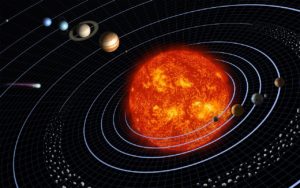
In 1993, Shoemaker co-discovered, with his wife, Carolyn Shoemaker, and David Levy, Comet Shoemaker-Levy 9 at California’s Palomar Observatory. This comet provided the first opportunity to predict and to observe a collision between two bodies in our solar system.
In 1992, as Comet Shoemaker-Levy 9 approached our largest planet, Jupiter, it broke up into 21 fragments. Each fragment later crashed into the planet at an astonishing 137,300 miles per hour. Seven to eight hours, on average, lapsed between impacts, which occurred from July 16 through July 22, 1994.
A few years earlier, NASA launched Galileo toward Jupiter, from the Space Shuttle Atlantis, on October 18, 1989. Its mission was to study the magnetic field and the planet’s moons. The spacecraft recorded the comet’s demise, which happened on the unseen night side of the planet. The Hubble Space Telescope also captured the event for scientists to analyze.
Gene Shoemaker died in a car collision near Alice Springs, Australia, on July 18, 1997, and his wife suffered severe injuries. On July 31, 1999, the Lunar Prospector space probe carried some of his ashes toward the moon. He is the first and only person to have ashes buried on any celestial body outside Earth. Yet another first.
My Friend, Deri
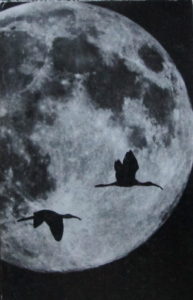
Deri’s card.
The Barringer family currently owns the Barringer Crater. Years ago, when I was selling plants at the Rockville Farmers’ Market, in Maryland, a good customer stopped by every week. We chatted about any subject under the sun… birds, dogs, dinosaurs, cameras… We became good friends, and I often worked on her property in town. She didn’t have family nearby, so she frequently spent holidays with me and my 2 kids.
She was a dear friend, and, unfortunately, passed away in 2003. Her name was Deri (Frederika) Barringer, granddaughter of Daniel Barringer. She spun fascinating tales of the family crater and of her travels across far-off continents, photographing for the National Geographic Society. Small world, when threads intersect.
After her death, she wanted to have her ashes dispersed over a river in Colorado. When the local beer company used water from that river, she declared that she would be “the life of the party”. That’s our Deri! This colorful character happily announced her wishes before she became seriously ill. And, when the time came, her brother complied.
